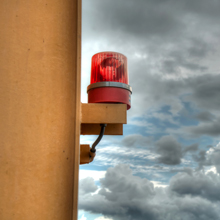 |
| People tend to be slow in responding to regular alarms in stressful situations and unfamiliar places |
Voice Alarm systems are one of the quickest ways to evacuate public and staff from a building. These are monitored at all times since they have to work during an emergency. In this article, Paul Ward from Bosch Security Systems explains how evacuation systems have evolved over time and how they have been classified depending on the identified risk.
In stressful situations and unfamiliar places, people are slow to respond to siren and bell alerts and lose valuable time reaching safety when every second counts. Often, they simply believe that ‘alarms’ are either false, a test or simply has nothing to do with them. Verbal instructions are therefore now widely considered to be the most effective way of notifying occupants of an emergency and instructing them where to go. A recent research showed that in an emergency, 13% of people react to bells, 45% of people react to text and 75% of people react to voice.
But that is only one part of the story. In order to be truly effective, the instructions must be transmitted over a VA system capable of maintaining good speech intelligibility over large distances. And the system must remain operational in the harshest environments, especially in the event of a fire. Not surprisingly, this is where most of the effort of manufacturers (like Bosch) has historically been concentrated.
Developing standards
The future will be the development of even more amplification power, and closer relationships between the professional audio and PA systems. |
VA systems are in effect Public Address (PA) systems that are highly secure and enhanced to meet stringent standards that are applied to Fire Alarm Systems. The simple systems of a decade or so ago, however, have moved on considerably in recent years. The amendment to BS5839 2008 has brought the VA Standard in line with the equivalent standards in the Fire Alarm industry.
Indeed this is one of the most significant changes in recent times. Another is the way in which evacuation procedures have been classified, depending on the type of building and the corresponding identified risk, from V1 to V5.
V1 covers situations where a pre-programmed evacuation plan is required, for example in small/medium-sized places of assembly such as shops, nightclubs etc. V2 builds on V1 but allows for live emergency messages to be made, for examples in office buildings, hotels, schools. V3 extends to situations where live emergency messages need to be broadcast in pre-determined zones, or groups of zones, such as in shopping centres, transport terminals and sports stadia.
 |
| Verbal instructions are considered to be the most effective way for emergency notification |
V4 systems cover all of the requirements of a V3 system, and in addition allow the facility to select and direct stored emergency messages into individual zones. V5 systems apply where the application falls outside of the scope of type V1-V4, and covers tailored solutions based on the assessment of special risks. Examples might include a building hosting several thousand people such as an exhibition centre, sports complex or congress venue.
The introduction of EN54-16 should bring greater certainty since all manufacturers’ technology will have to be independently tested. This in turn will allow like-for-like comparisons to be made between different manufacturers’ technologies, and a level playing field for all concerned.
Technology evolutions
Another notable trend has been the emergence of a new generation of amplifiers. Although the physical dimensions have not changed, the amount of power they can produce has increased substantially, and in some cases doubled. To add to that, the introduction of digital amplifiers have enabled hi-fi quality speech to be distributed over a wider area.
PA technology can now be integrated with CCTV and professional audio, providing interfaces into other systems that aid communications in other market sectors. An event now ‘seen’ by operators in a video monitoring centre, for example, can be accompanied by a pre-recorded warning or public safety announcement. Intruders can we warned off site, or told that they are being watched.
Speakers themselves can be individually ‘monitored’ over the electrical circuit so that if they are tampered with or vandalised, the rest of the system is not compromised nor lives put at risk. (This is especially useful in the higher-risk areas such as toilets in shopping centres).
The future will be the development of even more amplification power, and closer relationships between the professional audio and PA systems. This in turn will facilitate better sounding audio systems. Addressable speakers will also one day form an integral part of the Fire Alarm system, and more integration between the Fire Alarm Systems and Voice Alarm will continue.




